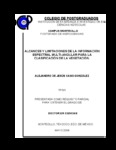| dc.description.abstract | El uso de información espectral multi-angular se ha justificado como una estrategia
para aumentar la precisión de los sistemas de clasificación de cultivos y vegetación
natural. En este trabajo se discuten los esquemas de caracterización de la
información espectral multi-angular asociada a la vegetación, así como su uso en los
sistemas de clasificación. Los resultados mostraron que, dejando fijo el fondo de la
vegetación, es posible discriminar sistemas arbolados y, cuando el fondo de la
vegetación varía, existe confusión con coberturas aéreas bajas. Por lo tanto, se
planteo un segundo experimento, presentando un modelo de los efectos del ángulo
cenital de visión e iluminación en las reflectancias bi-cónicas (Conical-Conical
Reflectance Factor, CCRF) de especies vegetales contrastantes y suelo desnudo.
Los resultados analizados para el efecto del suelo y la densidad de plantas muestran
que hay importantes zonas de confusión (traslape de información) entre las especies,
al considerar efectos combinados, para diversas diferencias acimutales. Estos
resultados ponen en duda el uso en forma generalizada de la información espectral
multi-angular y solo justifican este enfoque de clasificación si se dejan fijos el fondo
de la vegetación y la densidad de plantas (cantidad de follaje), situación irreal en un
sistema operacional. Debido a esto se presentó un esquema de modelación global
de los ángulos cenitales y acimutales en la reflectancia de la vegetación, extendiendo
los desarrollos al caso de los efectos de cambios en las propiedades ópticas del
fondo de la vegetación (suelos) y de la densidad de plantas (follaje), ratificándose el
problema de confusión en la discriminación de especies. Para poder concluir de
manera definitiva sobre el uso de la información multi-angular, se recomienda
realizar otro tipo de modelaciones, relacionando los parámetros B y las reflectancias
a nadir y el efecto multi-angular en las curvas iso-IAF. _____________The use of multi-angular spectral information has been justified like a strategy to
increase the precision of vegetation classification systems. In this work the schemes
of characterization of the multi-angular spectral information associated to the
vegetation, as well as its use in the classification systems are discussed. The results
showed that leaving the bottom of the vegetation unchanging, it is possible to
discriminate tree systems and, when the bottom of the vegetation varies, exist
confusion with low aerial covers. Therefore, a second experiment was considered to
analyze the discrimination of the vegetation under different approaches of
characterization, being presented a model of the effects of the zenithal angle of vision
and illumination in biconical reflectances (Conical-Conical Reflectance Factor, CCRF)
of contrast vegetal species and bare soil. The results analyzed for the effect of the
ground and the density of plants show that there are important zones of confusion
(overlaps of information) between the species, when considering combined effects,
for diverse azimuth differences. These results put in doubt the use in a generalized
form of the multi-angular spectral information and only justify its use if the bottom of
the vegetation and the density of plants (amount of foliage) are left unchanging,
unreal situation in an operational system. Due to this a scheme of global modeling of
the zenith and azimuth angles in the reflectance of the vegetation appeared,
extending the developments to the case of changes in the optical properties of the
bottom of the vegetation (grounds) and the density of plants (foliage), ratifying the
problem of confusion in the discrimination of species. In order to be able to conclude
in a definitive way on the use of the multi-angular information, it is recommended to
make another type of modeling, relating B parameters and nadir reflectance’s and
the multi-angular effect in the iso-IAF curves. | es |

